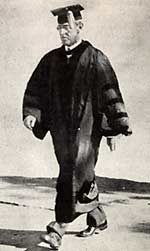
Page One
• Tilghman implements changes to support diversity efforts
• From obscurity to the spotlight
Inside
• Book chronicles Princeton’s rise from small college to intellectual powerhouse
• ‘Art of Science’ exhibition bridges disciplines
• Welders help students turn up the heat in architecture course
People
• Spotlight, staff retirements, staff obituaries, faculty resignations
• Briefs
Almanac
• Nassau Notes
• Calendar of events
• By the numbers

By the numbers
Woodrow Wilson

In his new book, James Axtell credits Woodrow Wilson with providing the foundation for Princeton to become a leading university. Here, Wilson walks to his last Commencement as University president in 1910. (Courtesy of Princeton University Archives)
Princeton NJ — In his new book, “The Making of Princeton University: From Woodrow Wilson to the Present” (see related story in this issue), James Axtell discusses one of Wilson’s well-known legacies: the preceptorial method of teaching.
In 1905, Wilson hired nearly 50 preceptors, doubling the size of the faculty and revolutionizing the University’s teaching system with the new guided readings and small-group discussions.
According to Axtell’s new book, the addition of the new faculty members may have changed the character of Princeton more than the preceptorial system did:
• The preceptor candidates were brought to campus during three months in the spring of 1905 for interviews with departments and Wilson. A meal with departmental representatives was obligatory. Hiring decisions were made in some cases by departmental vote and in others by the department chair and Wilson. The preceptors were offered one- to five-year contracts and salaries of $1,500 to $2,000.
• Axtell writes that the far-ranging search for the best talent “contributed to a significant and intellectually important reduction in the parochial character of Princeton.” Of the first 49 preceptors hired, 37 came from 25 other institutions; 12 were promoted from within the University.
• Of the 37 preceptors who had earned Ph.D. degrees, only three had received them from Princeton.
• In 1902 when Wilson took office, 68 percent of the faculty had Princeton degrees. When he left eight years later, the proportion of Princeton graduates on the faculty had decreased to 41 percent.